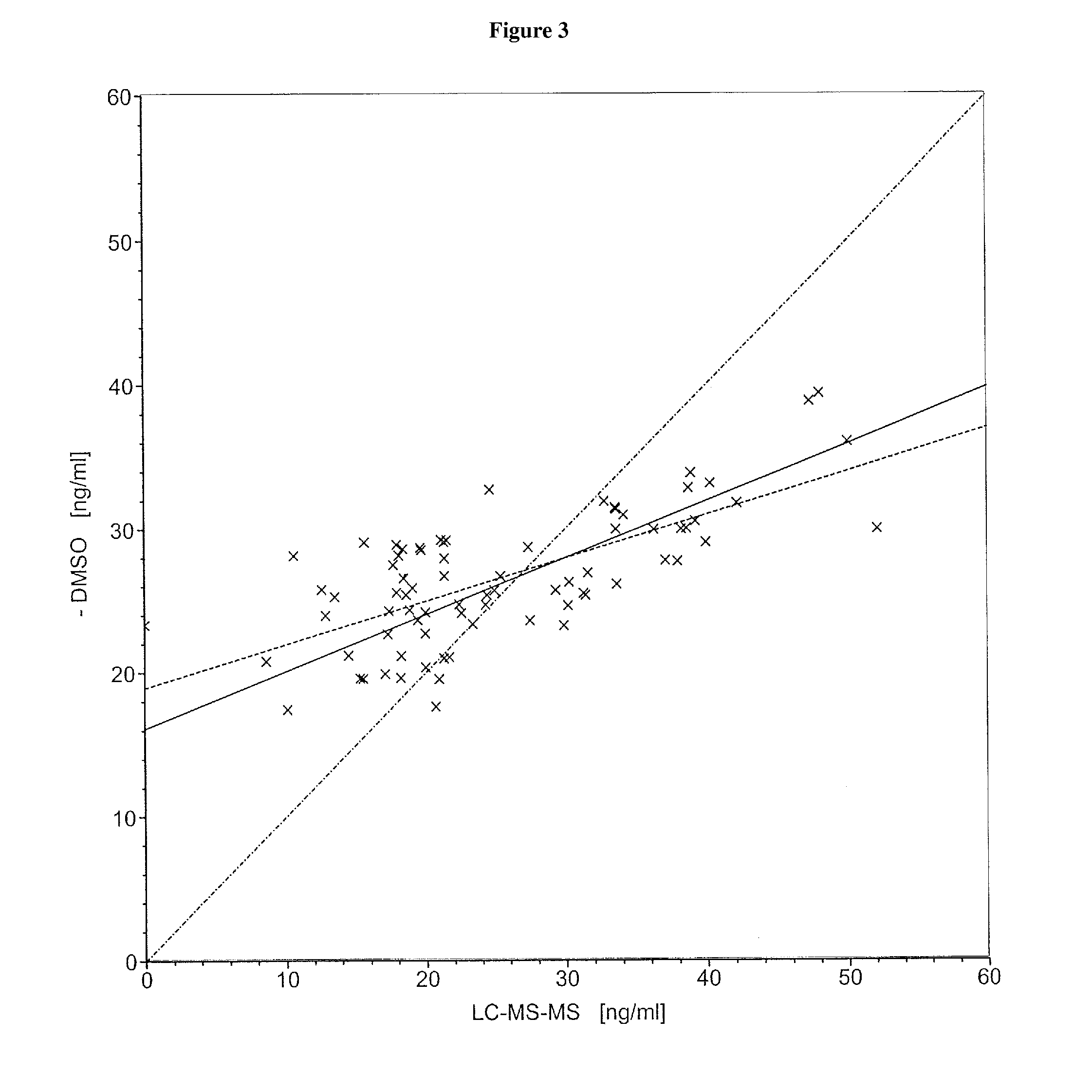Release reagent for vitamin d compounds
a technology of vitamin d and reagents, which is applied in the field of reagent composition, can solve the problems of vitamin d having a relatively short biological half-life in the circulation, 25-hydroxyvitamin d or other vitamin d compounds to the vitamin d-binding protein enormously complicating the determination of vitamin d compounds, and all available methods for determining vitamin d
- Summary
- Abstract
- Description
- Claims
- Application Information
AI Technical Summary
Benefits of technology
Problems solved by technology
Method used
Image
Examples
example 1
Synthesis of 25-hydroxyvitamin D3-3-hemisuccinate KLH
[0066]For this synthesis, 25-hydroxyvitamin D3 was chemically activated at position 3 (cf. Formula II) and coupled to KLH as an immunogen support. This synthesis was carried out via the intermediate steps 25-hydroxyvitamin D3-3-hemisuccinate and 25-hydroxyvitamin D3-3-hemisuccinate-N-hydroxysuccinimide ester.
1.1 Preparation of 25-hydroxyvitamin D3-3-hemisuccinate
[0067]10 mg (25 μmol) 25-hydroxyvitamin D2 (Sigma-Aldrich, No. H-4014) was dissolved in 1 ml absolute pyridine and stirred for 4 days at room temperature in the dark with 125 mg (1.25 mmol) succinic anhydride. The reaction mixture was taken up in 10 ml ethyl acetate and in each case washed with 2×10 ml water, 0.1 M hydrochloric acid and subsequently again with water. The organic phase was dried using about 1 g anhydrous sodium sulfate, filtered, and the solvent was removed in a vacuum. The residual solid was dried in a high vacuum. 10.5 mg (yield: 84%) of a colourless soli...
example 2
Generation and Isolation of Antibodies Against 25-hydroxyvitamin D3
2.1 Immunization
[0070]The antibodies were generated in sheep. The 25-hydroxyvitamin D3-3-hemisuccinate KLH conjugate from Example 1 was used for the immunization. The immunization dosage was 0.1 mg per animal. The first immunization was carried out in complete Freund's adjuvant. Further immunizations took place at 4 week intervals in incomplete Freund's adjuvant for a period of 10 months. Serum was collected in the middle of each immunization interval.
2.2 Purification of the Polyclonal Sheep Antibodies
[0071]The lipid-containing components were removed from the serum of the sheep immunized with 25-hydroxyvitamin D3-3-hemisuccinate-LKH conjugate with the aid of AEROSIL (Evonik Degussa GmbH) (1.5%). Subsequently the immunoglobulins were precipitated using ammonium sulfate (1.7 M). The precipitate was dialyzed against 15 mM potassium phosphate buffer containing 50 mM NaCl, pH 7.0 and subsequently purified chromatographi...
example 3
Assays for the Detection of 25-hydroxyvitamin D
[0090]Commercial assays were used according to the manufacturers' instructions. The 25-hydroxyvitamin D determinations were carried out by means of HPLC (test for 25(OH)vitamin D3, from the Immundiagnostik Company, Bensheim, order No. KC 3400) or by means of LC-MS-MS (Vogeser, M. et al., Clin. Chem. 50 (2004) 1415-1417) as described in the literature.
[0091]The preparation of the ingredients and the general test procedure for a new immunological test was described in the following:
3.1 Synthesis of hydroxyvitamin D2-3-3′-N-(hemisuberyl)aminopropyl-ether-biotin-(beta-Ala)-Glu-Glu-Lys(epsilon) conjugate (=Ag—Bi)
[0092]13.7 mg (25 μmol) hydroxyvitamin D2-3-3′-aminopropyl ether was dissolved in 3.5 ml DMSO, 28.7 mg (30 μmol) biotin-(beta-Ala)-Glu-Glu-Lys(epison)-hemi-suberate-N-hydroxysuccinimide ester (Roche Applied Science, No. 11866656) and 12.5 μl triethylamine were added, and it was stirred overnight at room temperature. The reaction solu...
PUM
| Property | Measurement | Unit |
|---|---|---|
| pH | aaaaa | aaaaa |
| volume percent | aaaaa | aaaaa |
| temperature | aaaaa | aaaaa |
Abstract
Description
Claims
Application Information
 Login to View More
Login to View More - R&D
- Intellectual Property
- Life Sciences
- Materials
- Tech Scout
- Unparalleled Data Quality
- Higher Quality Content
- 60% Fewer Hallucinations
Browse by: Latest US Patents, China's latest patents, Technical Efficacy Thesaurus, Application Domain, Technology Topic, Popular Technical Reports.
© 2025 PatSnap. All rights reserved.Legal|Privacy policy|Modern Slavery Act Transparency Statement|Sitemap|About US| Contact US: help@patsnap.com



